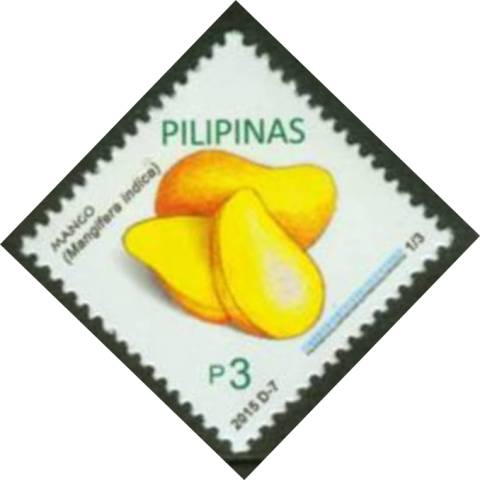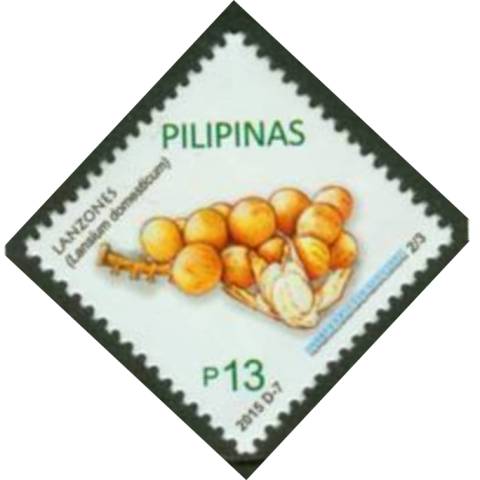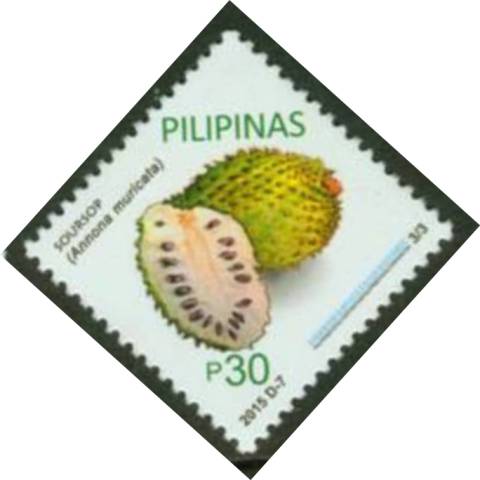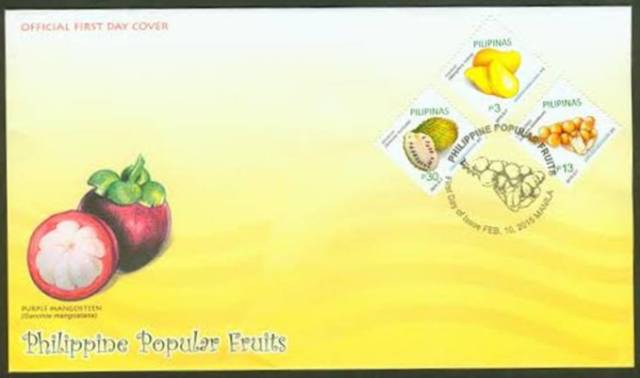2015, February 10. Popular Fruits of the Philippines (Definitives)
Litho Offset, Amstar Company, Inc., Perf 13.5
Singles, Sheets of 100



3p Mango (Mangifera Indica - Singles (2,000,000)
13p Lansones (Lansium domesticum) - Singles (250,000)
30p Guyabano (Soursop) (Annona muricata - Singles (1,250,000)
First Day Covers: Manila
Popular Fruits of the Philippines
3p Mango (Mangifera indica). The mango is a juicy stone fruit belonging to the genus Mangifera, consisting of numerous tropical fruiting trees, cultivated mostly for edible fruit. The mango is native to South and Southeast Asia, from where it has been distributed worldwide to become one of the most cultivated fruits in the tropics. While other Mangifera species are also grown on a more localized basis, Mangifera indica —the "common mango" or "Indian mango"—is the only mango tree commonly cultivated in many tropical and subtropical regions. It originated in Indian subcontinent (present day India and Pakistan) and Burma. It is the national fruit of India, Pakistan, and the Philippines. In several cultures, its fruit and leaves are ritually used as floral decorations at weddings, public celebrations, and religious ceremonies. http://en.wikipedia.org/wiki/Mango
13p Lansones (Lansium domesticum). Lansones is a tree growing to a height of 4 to 15 meters. Leaves are alternate, 20 to 40 centimeters long, with 5 to 7 leaflets, oblong to oblong-elliptic, 7 to 18 centimeters in length, and pointed at both ends. Flowers are small, yellow and borne on spikes, solitary or fascicled on the trunk or larger branches. Fruit is yellowish-white, occurring in bunches on a single stem, ellipsoid or globose, 2 to 4 centimeters long, with bitter seeds that are surrounded by a translucent pulp (arillus). The outer skin is thin and tough, abundant in a milky juice. The pulp occurs in five sections with one well-developed seed. Cultivated for its fruit in Luzon, particularly the Quezon and Laguna Provinces, and occurs wild in Mindanao and Basilan. http://www.stuartxchange.org/Lansones.html
30p Guyabano - Soursop (Annona muricata). Guyabano belongs to the family of Annonaceae, (A. muricata L.). The flesh of the fruit consist of a white edible pulp that is high in carbohydrates and considerable amounts of Vitamin C,Vitamin B1, Vitamin B2, Potassium and dietary fiber. Guyabano is low in cholesterol, saturated fat and sodium. Not only is guyabano a good health food, it also taste delicious. The tree and fruit is known in various names: Guyabano in Filipino, Soursop in English, Graviola in Brazil, and Guanabana in Spanish. http://www.philippineherbalmedicine.org/guyabano.htm
-
Fruits
